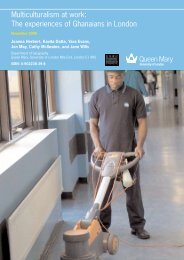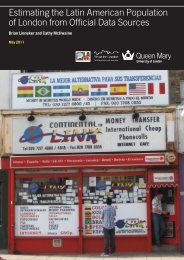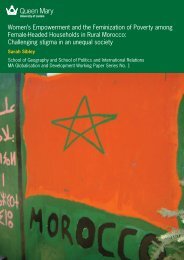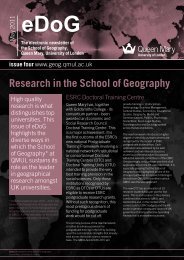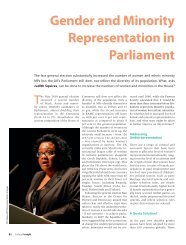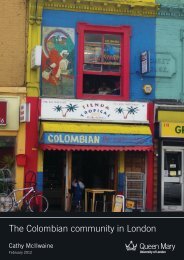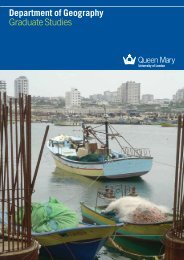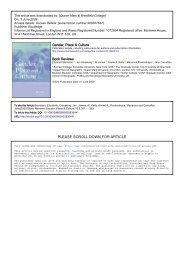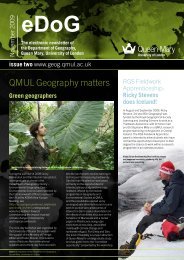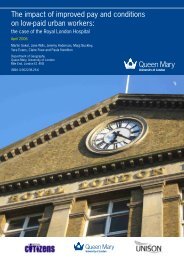Gender and Ethnic Identities among Low-paid Migrant Workers in ...
Gender and Ethnic Identities among Low-paid Migrant Workers in ...
Gender and Ethnic Identities among Low-paid Migrant Workers in ...
- No tags were found...
You also want an ePaper? Increase the reach of your titles
YUMPU automatically turns print PDFs into web optimized ePapers that Google loves.
“men of colour” are forced to compete for jobs <strong>in</strong> female-dom<strong>in</strong>ated low-<strong>paid</strong> sectors. Conversely,<br />
while participation <strong>in</strong> ethnic enclave economies may provide benefits for migrants <strong>in</strong> general, this<br />
may be much less so for women compared to men (Gilbertson 1995). This paper considers the<br />
ramifications of these complex processes <strong>in</strong> the context of low-<strong>paid</strong> migrant workers <strong>in</strong> London.<br />
Methodological issues<br />
Recently, there have been calls for adopt<strong>in</strong>g more holistic mixed methods approaches to the study<br />
of gender <strong>and</strong> migration (Donato et al. 2006). This has ma<strong>in</strong>ly been to counter claims that it is<br />
difficult to make generalisations from qualitative work on gender, while at the same time<br />
recognis<strong>in</strong>g that such studies can successfully uncover the dynamics <strong>and</strong> processes of gendered<br />
migration <strong>in</strong> ways that quantitative approaches cannot (Pessar <strong>and</strong> Mahler 2006). Thus, a comb<strong>in</strong>ed<br />
approach can be complimentary <strong>and</strong> productive for explor<strong>in</strong>g the lives of female <strong>and</strong> male migrants<br />
<strong>in</strong> holistic ways.<br />
In reflect<strong>in</strong>g such a perspective, this paper draws on a questionnaire survey <strong>and</strong> <strong>in</strong>-depth <strong>in</strong>terviews<br />
conducted with workers <strong>in</strong> low <strong>paid</strong> sectors of the London economy. Our broad aim was to explore<br />
who was work<strong>in</strong>g, <strong>and</strong> under what conditions, at the bottom end of the London labour market.<br />
Thus, the questionnaire survey (for which we worked with London’s Citizens <strong>and</strong> a team of eleven<br />
researchers) 1 sought to <strong>in</strong>vestigate the pay, work<strong>in</strong>g conditions, household circumstances <strong>and</strong><br />
migration histories of workers <strong>in</strong> four key sectors of London’s economy (see Evans et al. 2005;<br />
May et al 2006). These were contracted clean<strong>in</strong>g staff work<strong>in</strong>g on London Underground; general<br />
office clean<strong>in</strong>g; hospitality workers, particularly focused on luxury hotels; <strong>and</strong> home care<br />
employment. In addition, a number of workers <strong>in</strong> the food process<strong>in</strong>g <strong>in</strong>dustry were <strong>in</strong>cluded <strong>in</strong> the<br />
research. These were accessed through exist<strong>in</strong>g contacts with trade union representatives, through<br />
snowball<strong>in</strong>g <strong>and</strong> also via a r<strong>and</strong>om cold-call<strong>in</strong>g process. In total, 341 low <strong>paid</strong> workers were<br />
<strong>in</strong>terviewed of which 307 were migrants. The majority of <strong>in</strong>terviews were conducted face-to-face<br />
<strong>in</strong> a range of languages <strong>in</strong>clud<strong>in</strong>g Polish, Portuguese, Spanish <strong>and</strong> French. The migrants came from<br />
56 different countries with significant numbers from sub-Saharan Africa (55%) (especially Ghana<br />
<strong>and</strong> Nigeria), Lat<strong>in</strong> America <strong>and</strong> the Caribbean (15%) (especially Brazil, Colombia <strong>and</strong> Jamaica),<br />
Eastern Europe (10%) (especially Pol<strong>and</strong>), <strong>and</strong> Asia <strong>and</strong> South East Asia (7%). They <strong>in</strong>cluded a<br />
range of documented <strong>and</strong> undocumented migrants.<br />
In-depth <strong>in</strong>terviews followed on from the questionnaire survey <strong>and</strong> have been conducted by the<br />
authors. In the ma<strong>in</strong>, access to respondents has been facilitated by follow<strong>in</strong>g up on people who<br />
7



